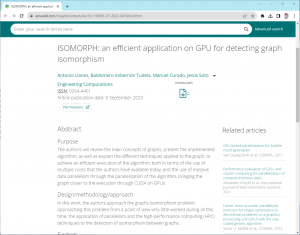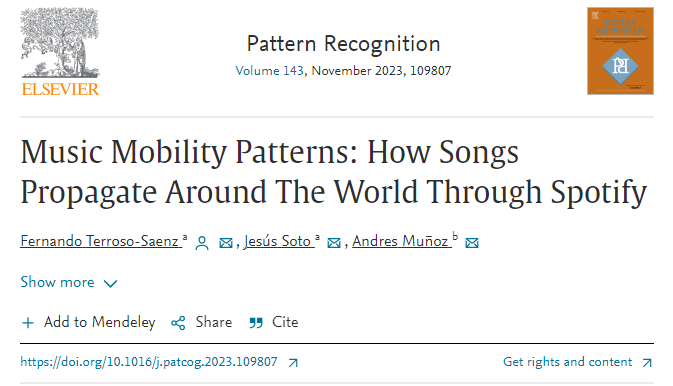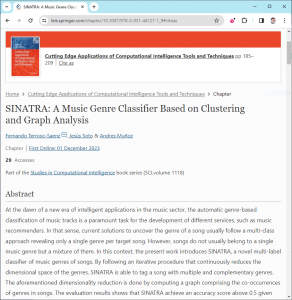 At the dawn of a new era of intelligent applications in the music sector, the automatic genre-based classification of music tracks is a paramount task for the development of different services, such as music recommenders. In that sense, current solutions to uncover the genre of a song usually follow a multi-class approach revealing only a single genre per target song. However, songs do not usually belong to a single music genre but a mixture of them. In this context, the present work introduces SINATRA, a novel multi-label classifier of music genres of songs. By following an iterative procedure that continuously reduces the dimensional space of the genres, SINATRA is able to tag a song with multiple and complementary genres. The aforementioned dimensionality reduction is done by computing a graph comprising the co-occurrences of genres in songs. The evaluation results shows that SINATRA achieve an accuracy score above 0.5 given genre space covering more than 2,000 music genres.
At the dawn of a new era of intelligent applications in the music sector, the automatic genre-based classification of music tracks is a paramount task for the development of different services, such as music recommenders. In that sense, current solutions to uncover the genre of a song usually follow a multi-class approach revealing only a single genre per target song. However, songs do not usually belong to a single music genre but a mixture of them. In this context, the present work introduces SINATRA, a novel multi-label classifier of music genres of songs. By following an iterative procedure that continuously reduces the dimensional space of the genres, SINATRA is able to tag a song with multiple and complementary genres. The aforementioned dimensionality reduction is done by computing a graph comprising the co-occurrences of genres in songs. The evaluation results shows that SINATRA achieve an accuracy score above 0.5 given genre space covering more than 2,000 music genres.
investigación
ISOMORPH: an efficient application on GPU for detecting graph isomorphism
Abstract
Music Mobility Patterns: How Songs Propagate Around The World Through Spotify
- A graph-based algorithm is proposed for detecting song propagation patterns in Spotify.
- Nodes are countries and edges reflect the frequent flow of songs across them.
- The patterns are reflected in cultural components such as language or migration flows.
- Predictors of song propagation based on the discovered patterns are discussed.
Abstract
Nowadays, music streaming services allow users to get instant access to an unprecedented amount of music of any type. This entails that songs, including potential new hits, can be discovered by listeners in any part of the globe and their propagation can be tracked through these streaming services. In this context, the present work focuses on recognizing the mobility patterns that songs follow in such a propagation among different countries of the world. To this end, this work defines a novel mechanism to uncover such mobility patterns of music from a directed-graph structure where nodes are countries and each edge reflects a frequent propagation of songs between pairs of countries. The resulting patterns reflect strong correlations with the migratory flows and the cultural and social similarities among regions. For instance, a propagation pattern was observed among North European countries with a good command of English. From such patterns, potential predictors for anticipating the mobility of a song are discussed. The results of this work can be beneficial for record companies and artists in their marketing campaigns for album releases and the organization of concerts and festivals.
Subjective mental workload in Spanish emergency nurses. A study on predictive factors
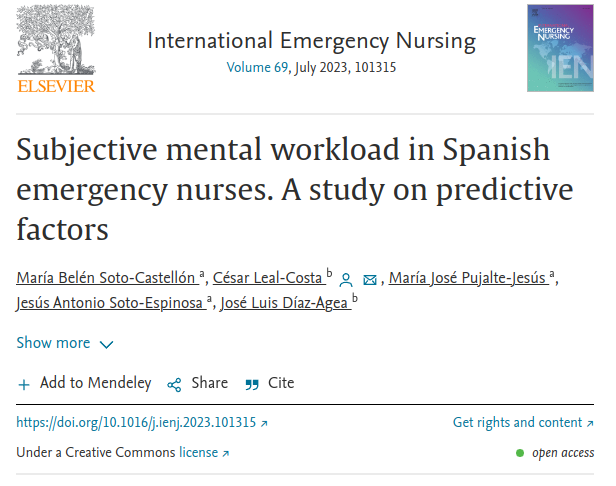 Mental workload refers to the cognitive or intellectual requirements that a worker is subjected to in a workday. The objective of the present work was to discover the subjective mental workload of nursing staff at Hospital Emergency Units, and its relationship with sociodemographic, work, environmental factors at the workplace, and personality variables. Method: A quantitative, descriptive, observational, and crosssectional study was conducted with 201 emergency nurses from 13 different provinces in Spain. Each participant completed 5 questionnaires (sociodemographic, work conditions, environmental conditions, personality, and subjective mental workload). Descriptive statistics were obtained, and Pearson’s correlations and multivariate models (multiple linear regression) were performed. Results: The nurses had medium to high levels of mental workload. The environmental conditions had a direct relationship with the mental workload, especially with respect to noise and lighting. The participants obtained high scores in kindness, responsibility, openness/intellect, and extraversion. Positive and statistically significant relations were found between neuroticism and mental workload. Being female, older, and having stable employment or a permanent contract were associated with a greater mental workload of emergency nurses. Conclusion: The domain of neuroticism personality, and the hygienic conditions in the workplace were the predictors with the most weight in the model. This study could be useful for defining aspects that need to be considered for the well-being of emergency nurses, such as lighting conditions or environmental noise in the workplace. It also invites reflection on the influence of personal factors (age, gender, personality) and work factors (type of contract, professional experience) on the mental workload of emergency nurses.
Mental workload refers to the cognitive or intellectual requirements that a worker is subjected to in a workday. The objective of the present work was to discover the subjective mental workload of nursing staff at Hospital Emergency Units, and its relationship with sociodemographic, work, environmental factors at the workplace, and personality variables. Method: A quantitative, descriptive, observational, and crosssectional study was conducted with 201 emergency nurses from 13 different provinces in Spain. Each participant completed 5 questionnaires (sociodemographic, work conditions, environmental conditions, personality, and subjective mental workload). Descriptive statistics were obtained, and Pearson’s correlations and multivariate models (multiple linear regression) were performed. Results: The nurses had medium to high levels of mental workload. The environmental conditions had a direct relationship with the mental workload, especially with respect to noise and lighting. The participants obtained high scores in kindness, responsibility, openness/intellect, and extraversion. Positive and statistically significant relations were found between neuroticism and mental workload. Being female, older, and having stable employment or a permanent contract were associated with a greater mental workload of emergency nurses. Conclusion: The domain of neuroticism personality, and the hygienic conditions in the workplace were the predictors with the most weight in the model. This study could be useful for defining aspects that need to be considered for the well-being of emergency nurses, such as lighting conditions or environmental noise in the workplace. It also invites reflection on the influence of personal factors (age, gender, personality) and work factors (type of contract, professional experience) on the mental workload of emergency nurses.
A simple method for the estimation of minimum and maximum air temperature monthly mean maps
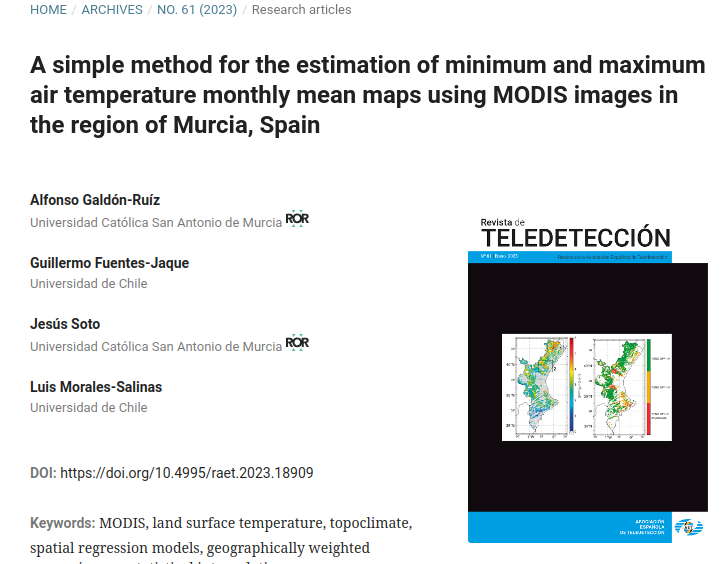 Air temperature records are acquired by networks of weather stations which may be several kilometres apart. In complex topographies the representativeness of a meteorological station may be diminished in relation to a flatter valley, and the nearest station may have no relation to a place located near it. The present study shows a simple method to estimate the spatial distribution of minimum and maximum air temperatures from MODIS land surface temperature (LST) and normalized difference vegetation index (NDVI) images. Indeed, there is a strong correlation between MODIS day and night LST products and air temperature records from meteorological stations, which is obtained by using geographically weighted regression equations, and reliable results are found. Then, the results allow to spatially interpolate the coefficients of the local regressions using altitude and NDVI as descriptor variables, to obtain maps of the whole region for minimum and maximum air temperature. Most of the meteorological stations show air temperature estimates that do not have significant differences compared to the measured values. The results showed that the regression coefficients for the selected locations are strong for the correlations between minimum temperature with LSTnight (R2 = 0.69–0.82) and maximum temperature with LSTday (R2 = 0.70–0.87) at the 47 stations. The root mean square errors (RMSE) of the statistical models are 1.0 °C and 0.8 °C for night and daytime temperatures, respectively. Furthermore, the association between each pair of data is significant at the 95% level (p<0.01).
Air temperature records are acquired by networks of weather stations which may be several kilometres apart. In complex topographies the representativeness of a meteorological station may be diminished in relation to a flatter valley, and the nearest station may have no relation to a place located near it. The present study shows a simple method to estimate the spatial distribution of minimum and maximum air temperatures from MODIS land surface temperature (LST) and normalized difference vegetation index (NDVI) images. Indeed, there is a strong correlation between MODIS day and night LST products and air temperature records from meteorological stations, which is obtained by using geographically weighted regression equations, and reliable results are found. Then, the results allow to spatially interpolate the coefficients of the local regressions using altitude and NDVI as descriptor variables, to obtain maps of the whole region for minimum and maximum air temperature. Most of the meteorological stations show air temperature estimates that do not have significant differences compared to the measured values. The results showed that the regression coefficients for the selected locations are strong for the correlations between minimum temperature with LSTnight (R2 = 0.69–0.82) and maximum temperature with LSTday (R2 = 0.70–0.87) at the 47 stations. The root mean square errors (RMSE) of the statistical models are 1.0 °C and 0.8 °C for night and daytime temperatures, respectively. Furthermore, the association between each pair of data is significant at the 95% level (p<0.01).
Evolution of global music trends
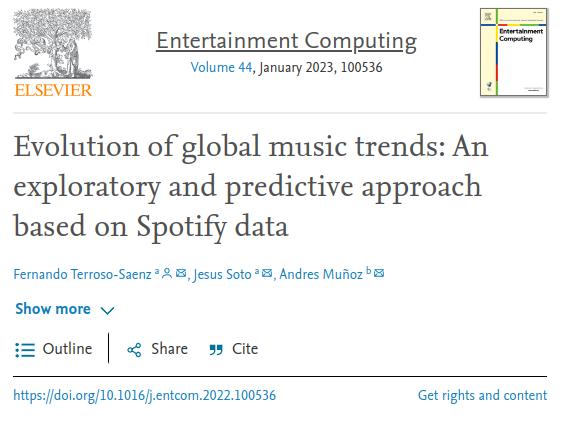 Evolution of global music trends: An exploratory and predictive approach based on Spotify data.
Evolution of global music trends: An exploratory and predictive approach based on Spotify data.
- An exploratory analysis of worldwide music listening trends is put forward.
- A drop in the global danceability of songs has occurred since 2020.
- A predictor to anticipate listening behaviours has been developed.
Music listening choices are considered to be a factor capable of measuring people’s emotions. Thanks to the explosion of streaming music applications in recent years, it is possible to describe listening trends of the global population based on emotional features. In this paper we have analysed the most popular songs from 52 countries on Spotify through their features of danceability, positivity and intensity. This analysis allows exploring how these song features reflect mood trends along with other contextual factors that may affect the population’s listening behaviour, such as the weather or the influence of the COVID-19 pandemic. Finally, we have proposed a multivariate time series model to predict the preferred type of music in those countries based on their previous music listening patterns and the contextual factors. The results show some relevant behavioural changes in these patterns due to the effect of the pandemic. Furthermore, the resulting prediction model enables forecasting the type of music listened to in three different groups of countries in the next 4 months with an error around 1%. These results may help to better understand streaming music consumption in businesses related to the music and marketing industry.
Evaluation of Clustering Algorithms on HPC Platforms
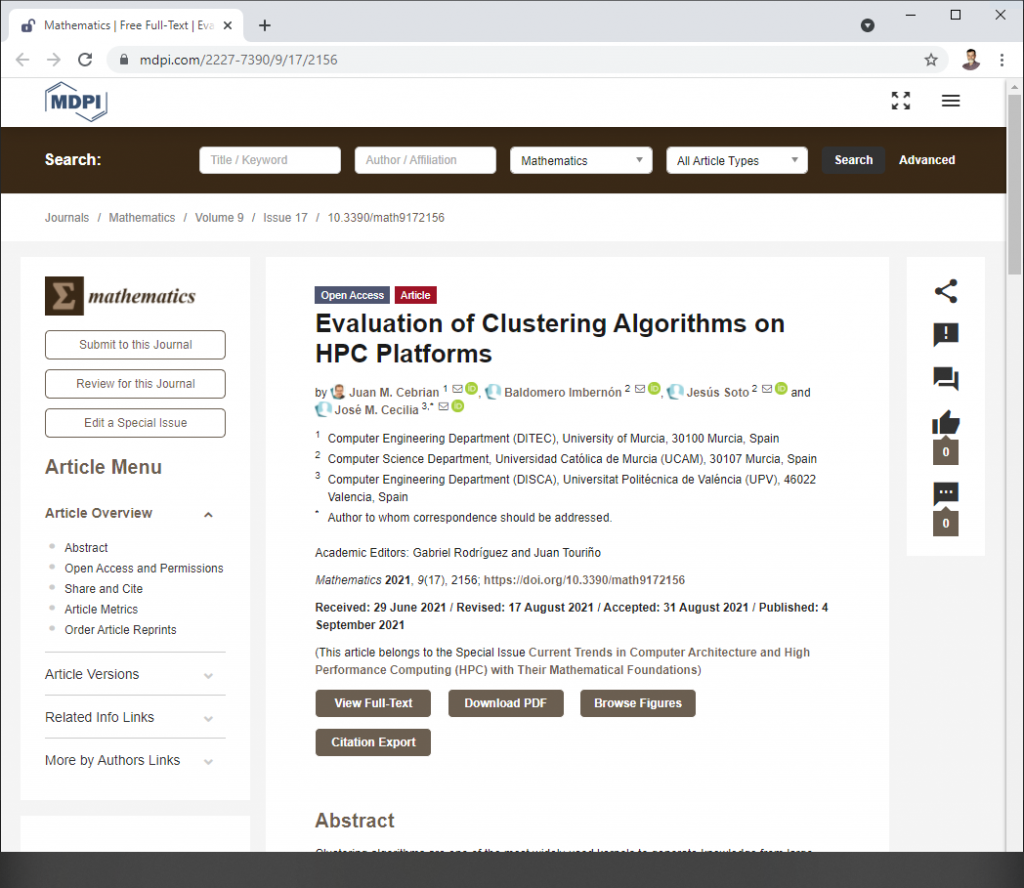
Clustering algorithms are one of the most widely used kernels to generate knowledge from large datasets. These algorithms group a set of data elements (i.e., images, points, patterns, etc.) into clusters to identify patterns or common features of a sample. However, these algorithms are very computationally expensive as they often involve the computation of expensive fitness functions that must be evaluated for all points in the dataset. This computational cost is even higher for fuzzy methods, where each data point may belong to more than one cluster. In this paper, we evaluate different parallelisation strategies on different heterogeneous platforms for fuzzy clustering algorithms typically used in the state-of-the-art such as the Fuzzy C-means (FCM), the Gustafson–Kessel FCM (GK-FCM) and the Fuzzy Minimals (FM). The experimental evaluation includes performance and energy trade-offs. Our results show that depending on the computational pattern of each algorithm, their mathematical foundation and the amount of data to be processed, each algorithm performs better on a different platform.
Antibióticos como contaminantes emergentes

La presencia de contaminantes emergentes en aguas es cada vez mayor. Especialmente preocupan los antibióticos, debido a que pueden dar lugar a la aparición de bacterias resistentes, pero también a que dichos antibióticos pueden afectar negativamente a los ecosistemas y a los organismos que los habitan. Los antibióticos empleados para el consumo humano terminan llegando a las estaciones depuradoras de aguas residuales (EDAR) donde se ha visto que se eliminan solo en parte…
Developing an intelligent system for the prediction of soil properties with a portable mid-infrared instrument
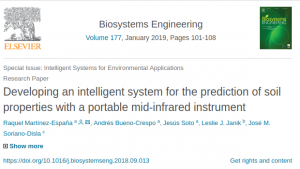 Ya está disponible nuestro nueva publicación.
Ya está disponible nuestro nueva publicación.
Developing an intelligent system for the prediction of soil properties with a portable mid-infrared instrument.
Highlights
- •Different machine learning techniques have been tested to predict soil properties.
- •The predicted soil properties are TC, TN, CEC, clay, silt and Na+.
- •The best predictive machine learning technique has been the Gaussian Process.
- •The Gaussian process is better compared to the traditional PLSR technique.
- •The Gaussian Process is the candidate for the development of intelligent system.
Air-Pollution Prediction in Smart Cities through Machine Learning Methods
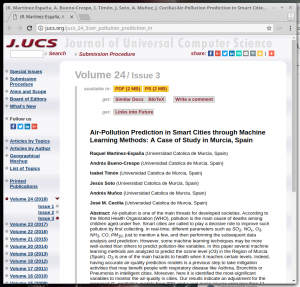
Estamos de suerte, al final nos han aceptado el artículo que llevamos meses en revisión.
Air-Pollution Prediction in Smart Cities through Machine Learning Methods: A Case of Study in Murcia, Spain
Abstract:Air-pollution is one of the main threats for developed societies. According to the World Health Organization (WHO), pollution is the main cause of deaths among children aged under five. Smart cities are called to play a decisive role to improve such pollution by first collecting, in real-time, different parameters such as SO2, NOx, O3, NH3, CO, PM10, just to mention a few, and then performing the subsequent data analysis and prediction. However, some machine learning techniques may be more well-suited than others to predict pollution-like variables. In this paper several machine learning methods are analyzed to predict the ozone level (O3) in the Region of Murcia (Spain). O3 is one of the main hazards to health when it reaches certain levels. Indeed, having accurate air-quality prediction models is a previous step to take mitigation activities that may benefit people with respiratory disease like Asthma, Bronchitis or Pneumonia in intelligent cities. Moreover, here it is identified the most-significant variables to monitor the air-quality in cities. Our results indicate an adjustment for the proposed O3 prediction models from 90% and a root mean square error less than 11 μ/m3 for the cities of the Region of Murcia involved in the study.
- 1
- 2
